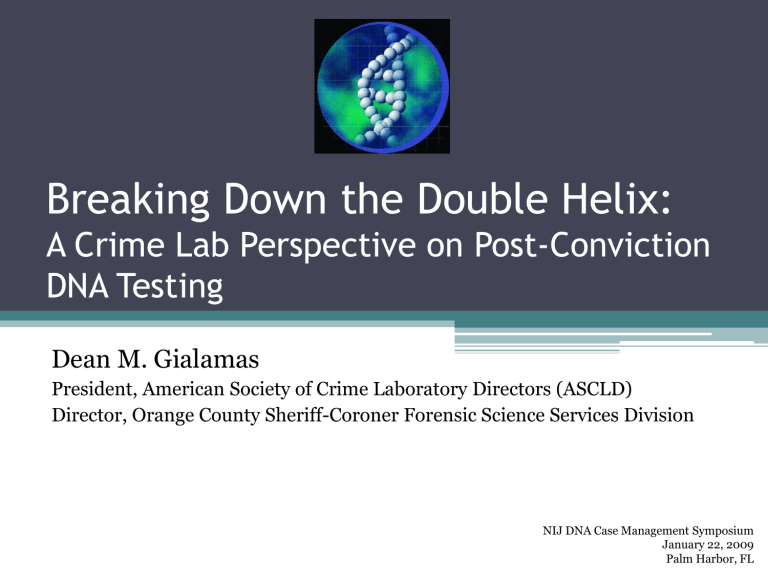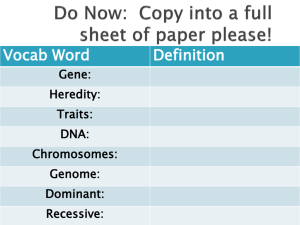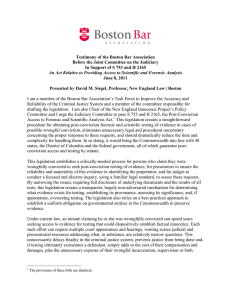Breaking Down the Double Helix: Crime Labs and Post

Breaking Down the Double Helix:
A Crime Lab Perspective on Post-Conviction
DNA Testing
Dean M. Gialamas
President, American Society of Crime Laboratory Directors (ASCLD)
Director, Orange County Sheriff-Coroner Forensic Science Services Division
NIJ DNA Case Management Symposium
January 22, 2009
Palm Harbor, FL
DNA and Post-Conviction Cases
• No single forensic discipline has had more impact on post-conviction cases than DNA
• Technology advancement has brought a sense of both excitement and disappointment to the criminal justice community
• Databases, and in particular the sharing of information, has been the most remarkable impact to solving (and preventing) crime in forensic science
Crime Lab Post-Conviction Issues
• Case identification and evaluation
• Locating and preserving evidence
▫ Case record review
• Laboratory testing
▫ Evidence selection
▫ Technology selection
▫ Laboratory selection
▫ Database “technology”
▫ Reporting and notification
Locating and Preserving Evidence
• Locate and review evidence chain of custody documentation
▫ Evidence may also be in courts, police property rooms, hospitals, medical examiner offices, and private labs
• Locate and review the laboratory case file, including all crime scene and laboratory reports and notes
▫ Previously prepared sample splits
▫ Sample extracts remaining from original or previous lab analyses
▫ Determine if other laboratory analyses would have evidence remaining (e.g., micro slides)
• Also consider the need for reference samples
▫ May need to obtain secondary reference samples
• Communication and collaboration with the local crime lab may be key in locating evidence
Laboratory Testing
• Evidence Selection
▫ Determine what probative question needs to be answered and if the current state of technology can answer that question
Evidence may not be limited to items previously examined – may include samples not tested, biological samples previously not detected, or samples previously unsuitable for testing
▫ DNA is not the “be all” technology
Determine if other forensic disciplines can answer the probative question
Other disciplines may corroborate/refute witness testimony or may be faster, cheaper
▫ Use your experts to assist – whether a local crime lab or privately retained
Laboratory Testing
• Technology Selection
▫ Determine what technology was previously used and the conclusions formed (e.g., inconclusive results)
▫ Determine if and/or what current technology will answer the probative questions (e.g., nuclear-STR’s,
Y-STR’s, mt-DNA, mini-STR’s)
▫ Consider touch/trace DNA sampling and testing
▫ Consider non-traditional DNA samples for testing
Traditional Sources of DNA
• Blood
• Semen
• Vaginal fluid
• Saliva
• Skin tissue
• Hair
• Urine
• Bone
• Teeth
White blood cells
Spermatozoa and other cells
Cells in lining
Cells that line the mouth
Nucleated skin cells
Roots with attached cells
Cells shed in the liquid
Where We Also Find DNA
• Drink Containers
• Food / Candy Wrappers
• Toothpicks
• Straws
• Gloves
• Cables / Cords
• Jewelry Boxes
• Caps and Hats
• Clothing
• Cigarette Butts
• Doors & Windows
• Handled Tools and Weapons
• Zip Ties and Rope
• Rocks
Laboratory Testing
• Laboratory Selection
▫ Determine which laboratory will be selected or agreed upon for the analysis of the evidence
Experience, accreditation, technology available, location
▫ Consider cost implications for private labs (analysis and testimony)
Federally funded assistance programs
▫ Consider resource implications for public labs
Current workload issues and backlogs
▫ Determine if the analysis will need to be supervised or monitored and by whom
▫ Weigh benefits and disadvantages of consuming samples and, more importantly, who makes that call
Laboratory Testing
• Database “Technology”
▫ Determine if profiles can/should be uploaded to
CODIS
Consider new NDIS upload rules for private lab sample testing in July 2009
▫ Determine if profiles can/should be run against any local or regional databases
▫ Limitations of DNA databases
Qualifying samples in database
Partial matching / familial searching considerations
▫ RFLP, DQa , Y-STR’s, and mt-DNA not compatible with current DNA databases
Laboratory Testing
• Reporting and Notification
▫ Laboratory report distribution may vary by local protocol or mandate
▫ Determine who will receive reports and/or notifications on testing progress and results
▫ Determine when and how the information will be shared with all interested parties
Effective Post-Conviction Testing
Some of the most important tools to a successful postconviction review process include:
Excellent coordination and communication amongst those involved (prosecutor, defense attorney, and crime lab)
Well defined and articulated procedures or protocols for handling post-conviction cases
Knowledgeable understanding of forensic science technology or availability of experts to assist
The Power of Physical Evidence:
The Silent Witness
Wherever he steps, whatever he touches, whatever he leaves, even unconsciously, will serve as a silent witness against him. Not only his fingerprints, but his hair, the fibers from his clothing, the glass he breaks, the tool mark he leaves, the paint he scratches, the blood or semen he deposits or collects.
All of these and more bear mute witness against him. This is evidence that does not forget… Only physical evidence is infallible, and then only when it is properly recognized, studied, and interpreted.
- Paul Kirk .









